2017 MERCEDES-BENZ E-CLASS ESTATE ESP
[x] Cancel search: ESPPage 252 of 585
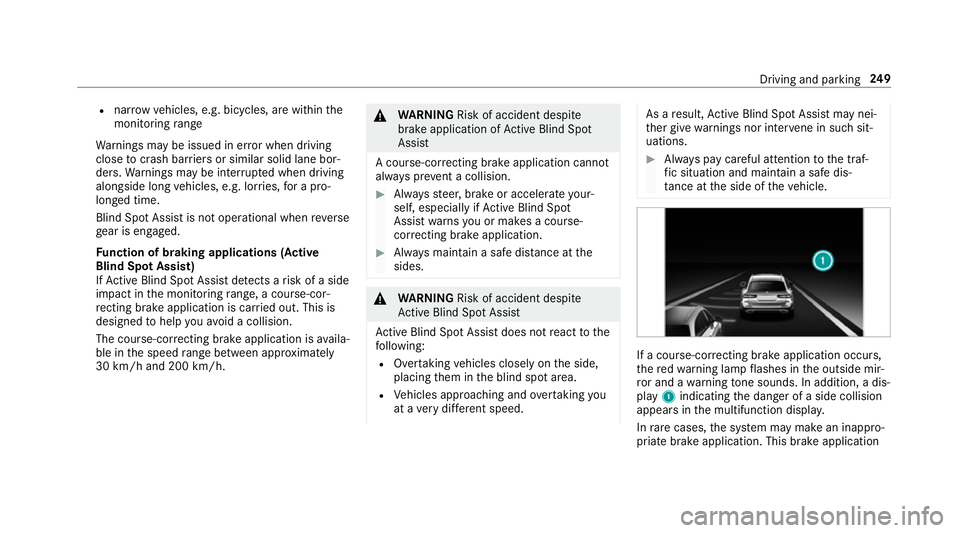
R
narrowv ehicles, e.g. bicycles, ar ewithin the
monitoring range
Wa rnings ma ybeissued in er rorw hen driving
close tocrash ba rrier sors imilar solid lane bor‐
ders. Warnings ma ybeinterrupte dw hen driving
alongside long vehicles, e.g. lor ries, forap ro‐
longed time.
Blind Spo tAssis tisn otoperationa lwhen reve rse
ge ar is engaged.
Fu nction of braking applications (Active
Blind Spo tAssist)
If Ac tiveB lind Spo tAssistdetects arisk of aside
impact in them onitoring range, acourse-cor‐
re cting brak eappli cation is car ried out. This is
designed tohelp youa void ac ollision.
The course-cor recting brak eappli cation is availa‐
ble in thes peed rang eb etwe en appr oximately
30 km/h and 200 km/h. &
WARNING Risk of accident despi te
brak eapplication of ActiveB lind Spot
Assi st
Ac ourse-co rrecting brak eapplication cann ot
alw aysp reve nt ac ollision. #
Alw ayss teer,b rake or accelera teyour‐
self ,especiall yifActiveBlind Spot
Assi stwa rnsy ou or makes acourse-
co rrecting brak eapplication. #
Alw aysm aintain asafed ista nce at the
sides. &
WARNING Risk of accident despi te
Ac tiveB lind Spo tAssist
Ac tiveB lind Spo tAssistdoes no treact tothe
fo llowing:
R Over taking vehicles closely on thes ide,
placing them in theb lind spo tarea.
R Vehicles approaching and overtakin gyou
at av eryd iffe re nt speed. As
aresult, ActiveB lind Spo tAssistma ynei‐
th er giv ewarning snor inter vene in su chsit‐
uations. #
Alw aysp aycareful attention tothet raf‐
fi cs ituation and maintai nasafed is‐
ta nce at thes ide of thev ehicle. If
ac ourse-cor recting brak eappli cation occu rs,
th er ed warning lam pflashes in theo utside mir‐
ro ra nd aw arning tone sounds. In addition, adis‐
pl ay 1 indicatin gthe danger of aside collision
appear sinthe multifunction displa y.
In rare cases, thes ystemm aymak eani nappro‐
priat ebrake application. This brak eapplication Driving and parking
249
Page 253 of 585
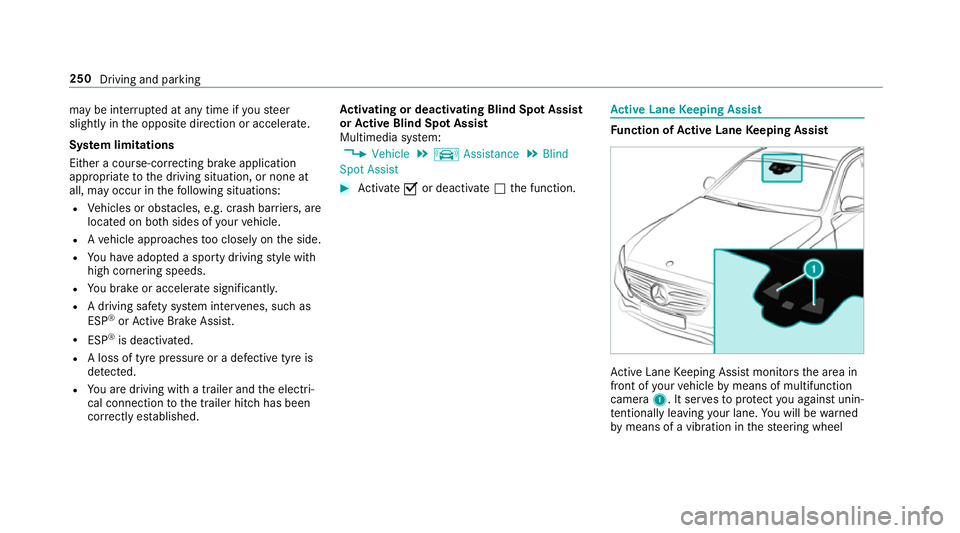
ma
ybei nterrupte data nytime if yous teer
slightl yinthe opposit edirection or accelera te.
Sy stem limitations
Either acourse-cor recting brak eappli cation
appropria teto thed riving situation ,ornoneat
all, ma yoccur in thef ollowing situations:
R Vehicles or obs tacles, e.g. crash ba rriers, are
located on bo thsides of your vehicle.
R Avehicle approaches tooc losely on thes ide.
R Youh avea dop tedas porty driving stylew ith
high cornering speeds.
R Youb rake or accelerat esignificantl y.
R Adriving sa fety sy stem inter venes, su chas
ESP ®
or ActiveB rake Assi st.
R ESP ®
is deacti vated.
R Aloss of tyr epressur eorad efectivetyreis
de tected.
R Youa redrivin gwithat railer and thee lectri‐
cal connection tothet railer hitc hhas been
cor rectly es tablished. Ac
tivatin gordeactivatin gBlind Spo tAssist
or Activ eB lind Spo tAssist
Multimedia sy stem:
, Vehicle .
k Assistance .
Blind
Spot Assist #
Activate Oor deacti vate ª thef unction. Ac
tiv eL aneK eeping Assist Fu
nction of Activ eL aneK eeping Assist Ac
tiveL aneK eeping Assis tmonitor sthe area in
front of your vehicle bymeans of multifunction
camera 1.Itserve stop rotect youa gains tunin‐
te ntional lyleavin gyour lane. Youw ill be warned
by means of avibration in thes teering wheel 250
Driving and parking
Page 254 of 585
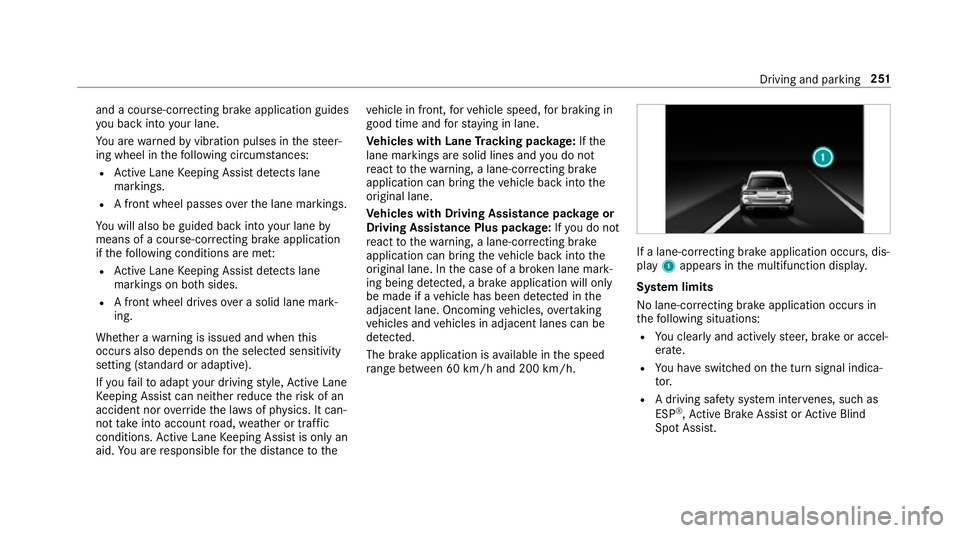
and
acourse-cor recting brak eappli cation guides
yo ub acki ntoy our lane.
Yo ua rewa rned byvibration pulses in thes teer‐
ing wheel in thef ollowing circums tances:
R ActiveL aneK eeping Assis tdetects lane
markings.
R Afront wheel passe soverthe lane markings.
Yo uw ill also be guided bac kintoy our lane by
means of acourse-cor recting brak eappli cation
if th ef ollowing condition sareme t:
R ActiveL aneK eeping Assis tdetects lane
markings on bo thsides.
R Afront wheel drives overas olidl ane mark‐
ing.
Whe ther aw arning is issued and when this
occur salso depends on thes elected sensitivity
setting (s tanda rdor adaptive).
If yo uf ail toadap tyour driving style, Ac tiveL ane
Ke eping Assis tcan neither reduce ther isk of an
accident nor override thel aw sofp hysics. It can‐
no ttak ei ntoa ccount road, weather or traf fic
conditions .Activ eLaneK eeping Assis tisonlyan
aid. Youa re re sponsible fort he dis tance tothe ve
hicle in front, forv ehicle speed, forb raking in
good time and fors taying in lane.
Ve hicles with Lane Tracking pac kage:Ifthe
lane markings ar esolid lines and youdon ot
re act tothew arning ,alane-cor recting brake
application can bring thev ehicle bac kintot he
original lane.
Ve hicles with Drivin gAssistanc epacka ge or
Driving Assistance Plus pa ckage: Ifyo udon ot
re act tothew arning ,alane-cor recting brake
application can bring thev ehicle bac kintot he
original lane. In thec ase of abroke nl ane mark‐
ing being de tected, abrake application will only
be mad eifavehicle has been de tected in the
adjacent lane .Oncoming vehicles, overtaking
ve hicles and vehicles in adjacent lanes can be
de tected.
The brak eappli cation is available in thes peed
ra ng eb etwe en 60 km/h and 200 km/h. If
al an e-co rrecting brak eapplication occurs, dis‐
play 1appear sinthe multifunction displa y.
Sy stem limits
No lane-cor recting brak eappli cation occu rsin
th ef ollowing situations:
R Youc lear lyand activel ysteer,b rake or accel‐
erate.
R Youh ave switched on thet urns ignal indica‐
to r.
R Adriving sa fety sy stem inter venes, su chas
ESP ®
,A ctiv eBrake Assi stor ActiveB lind
Spo tAssist. Driving and pa
rking 251
Page 255 of 585
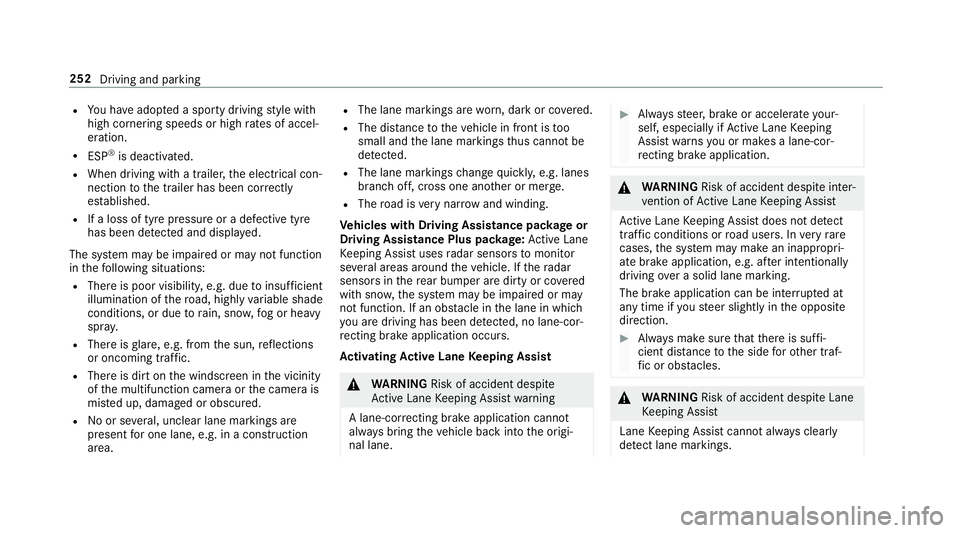
R
Youh avea dop tedas porty driving stylew ith
high cornering speeds or high ratesofa ccel‐
eration.
R ESP ®
is deactivated.
R When driving wit hatrailer, thee lectrical con‐
nection tothet railer has been cor rectly
es tablished.
R Ifal oss of tyr epressur eorad efectivetyre
has been de tected and displ ayed.
The sy stem ma ybeimpaired or ma ynotfunction
in thef ollowing situations:
R Ther eisp oor visibilit y,e.g. due toinsuf ficient
illumination of ther oad, highly variable shade
conditions, or due torain, sno w,fogorh eavy
spr ay.
R Ther eisg lare, e.g. from thes un, reflections
or oncoming tra ffic.
R Ther eisd irtont he windscreen in thev icinity
of them ultifunction camer aorthe camer ais
mis tedu p, damaged or obscured.
R No or se veral, unclear lane markings are
presen tfor one lane, e.g. in aconstruction
area. R
The lane markings ar eworn, dar korcovered.
R The dis tance tothev ehicle in front is too
small and thel ane markings thus canno tbe
de tected.
R The lane markings chang equickl y,e.g. lanes
branc hoff,c ross one ano ther or mer ge.
R The road is very nar rowa nd winding.
Ve hicles with Drivin gAssistanc epacka ge or
Driving Assistance Plus pa ckage: ActiveL ane
Ke eping Assis tuses radar sensor stomonitor
se verala reas around thev ehicle. If ther adar
senso rsinther ear bumper ar edirty or co vered
wit hs now, thes ystemm aybe impaired or may
no tfunction .Ifano bstacle in thel ane in which
yo ua redrivin ghas been de tected, no lane-cor‐
re cting brak eappli cation occu rs.
Ac tivatin gActive Lan eKeeping Assist &
WARNING Risk of accident despi te
Ac tiveL aneK eeping Assis twarning
Al ane-cor recting brak eappli cation cannot
al wa ys bring thev ehicle bac kintot he origi‐
nal lane. #
Alw ayss teer,b rake or accelera teyour‐
self ,especiall yifActiveLaneK eeping
Assis twarns youorm akesalane-cor‐
re cting brak eappli cation. &
WARNING Risk of accident despi teinter‐
ve ntio nofA ctiveLaneK eeping Assist
Ac tiveL aneK eeping Assis tdoes no tdetect
traf ficc onditions or road users. In very rare
cases, thes ystem ma ymakeani nappropri‐
at eb rake application, e.g. af teri ntentional ly
driving overas olidl ane marking.
The brak eapplication can be inter rupte dat
an yt ime if yous teer slightl yinthe opposite
direction. #
Alw aysm akes uret hat ther eiss uffi‐
cient di stanc etot he side foro ther traf‐
fi coro bstacles. &
WARNING Risk of accident despi teLane
Ke eping Assist
Lane Keeping Assis tcann otalw aysc learly
de tect lane markings. 252
Driving and pa rking
Page 256 of 585
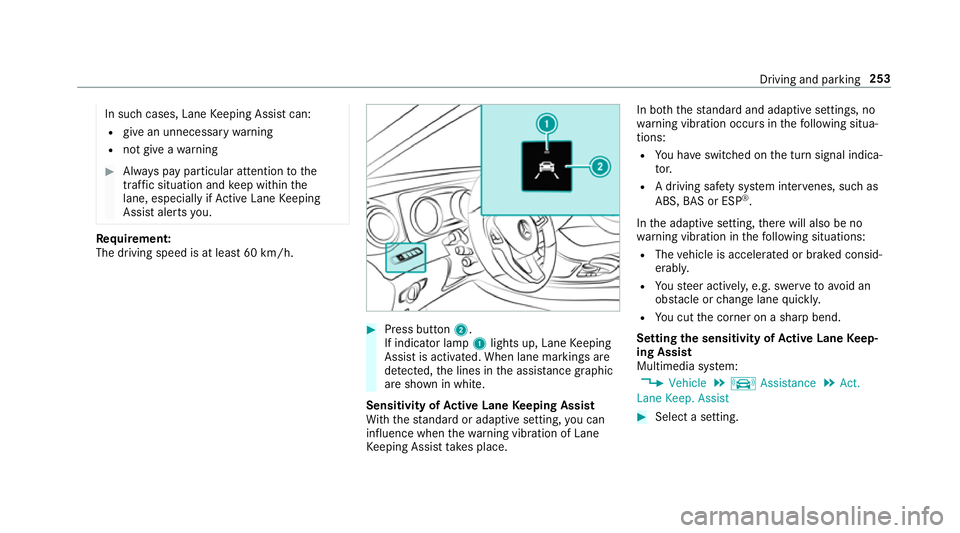
In suc
hcases, Lane Keeping Assis tcan:
R giveanu nnecessar ywarning
R notg iveaw arning #
Alw aysp ayparticular attention tothe
traf fics ituation and keep within the
lane, especiall yifActiveLaneK eeping
Assis talerts you. Re
quirement:
The driving speed is at leas t60k m/h. #
Press button 2.
If indicator lamp 1lights up, Lane Keeping
Assis tisactivated. When lane marking sare
de tected, thel ines in thea ssis tance graphic
ar es hown in white.
Sensitivity of Activ eL aneK eeping Assist
Wi th th estandar dora daptiv esetting ,you can
influence when thew arning vibration of Lane
Ke eping Assis ttakes place. In bo
th thestandar dand adaptiv esettings, no
wa rning vibration occur sinthefollowing situa‐
tions:
R Youh ave switched on thet urns ignal indica‐
to r.
R Adriving sa fety sy stem inter venes, su chas
ABS, BASorE SP®
.
In thea daptiv esetting, ther ew ill also be no
wa rning vibration in thef ollowing situations:
R The vehicle is accelerated or braked consid‐
erably.
R Yous teer actively ,e.g. swer vetoavo id an
obs tacle or chang elane quickl y.
R Youc utthec orner on ashar pbend.
Setting thes ensitivit yofActive Lan eKeep‐
ing Assist
Multimedia sy stem:
, Vehicle .
k Assistance .
Act.
Lane Keep. Assist #
Select asetting. Driving and parking
253
Page 259 of 585
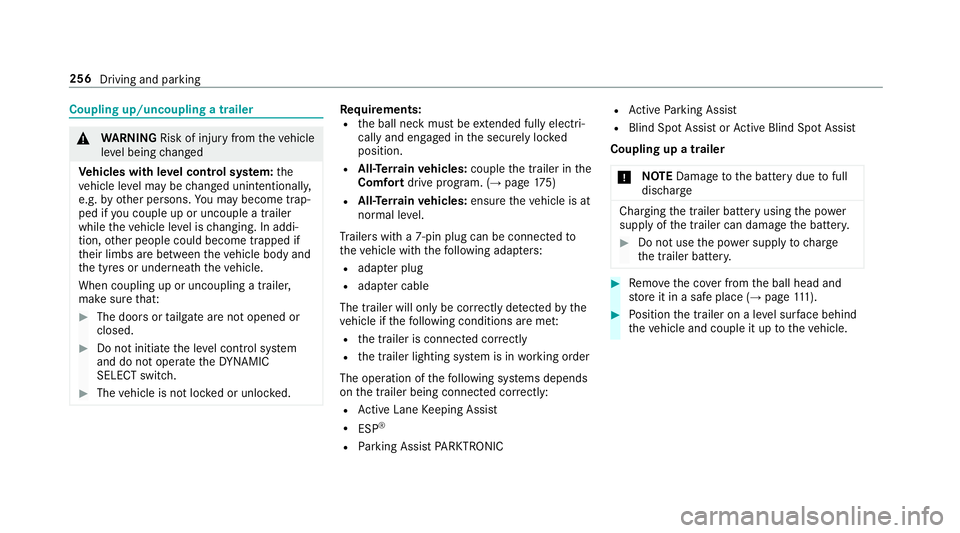
Coupling up/uncouplin
gatrailer &
WARNING Risk of inju ryfrom thev ehicle
le ve lb eing changed
Ve hicles with le velc ontrol sy stem: the
ve hicle le velm aybe changed unin tentional ly,
e.g. by ot her persons. Youm aybecome trap‐
ped if youc ouple up or uncouple atrailer
while thev ehicle le velisc hanging. In addi‐
tion, other people could become trapped if
th eir limbs ar ebetwe en thev ehicle body and
th et yres or underneat hthe vehicle.
When coupling up or uncoupling atrailer,
mak esuret hat: #
The door sortailgat earenoto pened or
closed. #
Do no tinitiat ethe le velc ontrol sy stem
and do no toperat ethe DYNA MIC
SELECT switch. #
The vehicle is no tloc kedoru nlocked. Re
quirements:
R theb all nec kmustbee xtende dfully electri‐
cal lyand engaged in thes ecurel yloc ked
position.
R All-Terrain vehicles: couplethe trailer in the
Comfort driveprogram. (→ page175)
R All-Ter rain vehicles: ensurethe vehicle is at
normal le vel.
Tr ailer switha7 -pin plug can be connec tedto
th ev ehicle wit hthe following adap ters:
R adap terp lug
R adapte rcable
The trailer willo nly be correctly de tected bythe
ve hicle if thef ollowing condition sareme t:
R thet railer is connected cor rectly
R thet railer lighting sy stem is in working order
The operation of thef ollowing sy stems depends
on thet railer being connected cor rectly:
R ActiveL aneK eeping Assist
R ESP ®
R Parking Assis tPARKTRONIC R
ActiveP arking Assist
R Blin dSpotA ssis torA ctiveBlind Spo tAssist
Coupling up atrailer
* NO
TEDama getotheb atter ydue tofull
discharge Charging
thet railer batter yusing thep ower
supply of thet railer can damag ethe batter y. #
Do no tuse thep owe rsupp lyto charge
th et railer batter y. #
Remo vethec ove rfromt he ball head and
st or eitinas afep lace (→ page111). #
Position thet railer on alevel sur face behind
th ev ehicle and couple it up tothev ehicle. 256
Driving and parking
Page 270 of 585
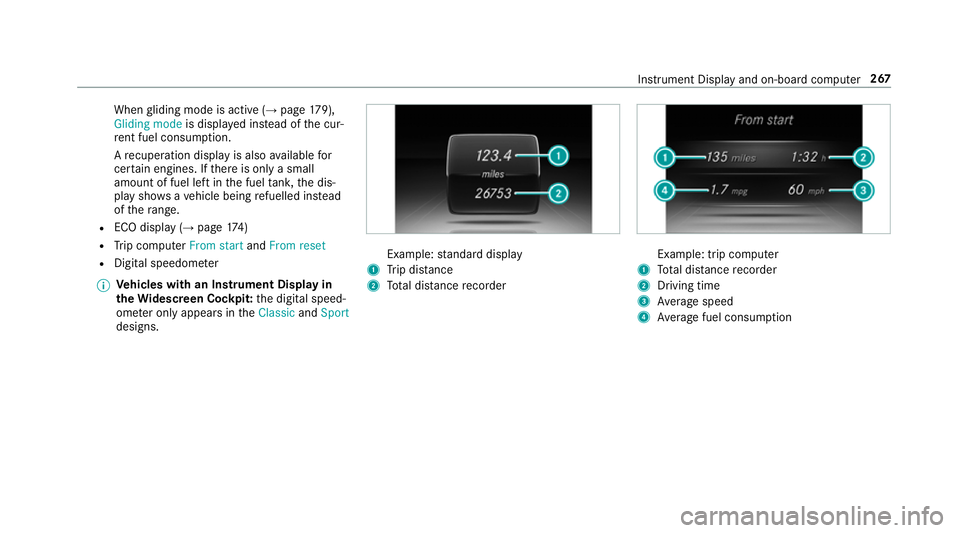
When
gliding mode is activ e(→pag e179),
Gliding mode is displayedi nstead of thec ur‐
re nt fue lconsu mption.
Ar ecuperation displa yisalsoavailable for
cer tain engines. If ther eiso nlyas mall
amount of fuel lef tinthe fuel tank ,the dis‐
pla yshows avehicle being refuelled ins tead
of ther ange.
R ECOd ispl ay ( →pag e174 )
R Trip computer Froms tart and Fromr eset
R Digital speedom eter
% Ve
hicles with an Instrument Displa yin
th eW idescreen Cockpit: thed igital speed‐
ome tero nly appear sintheClassic andSport
designs. Example:
standar ddisplay
1 Trip dis tance
2 Totald ista nce recorder Example: trip compu
ter
1 Totald ista nce recorder
2 Driving time
3 Averag espeed
4 Averag efuel consum ption Instrumen
tDispla yand on-boar dcomputer 267
Page 277 of 585
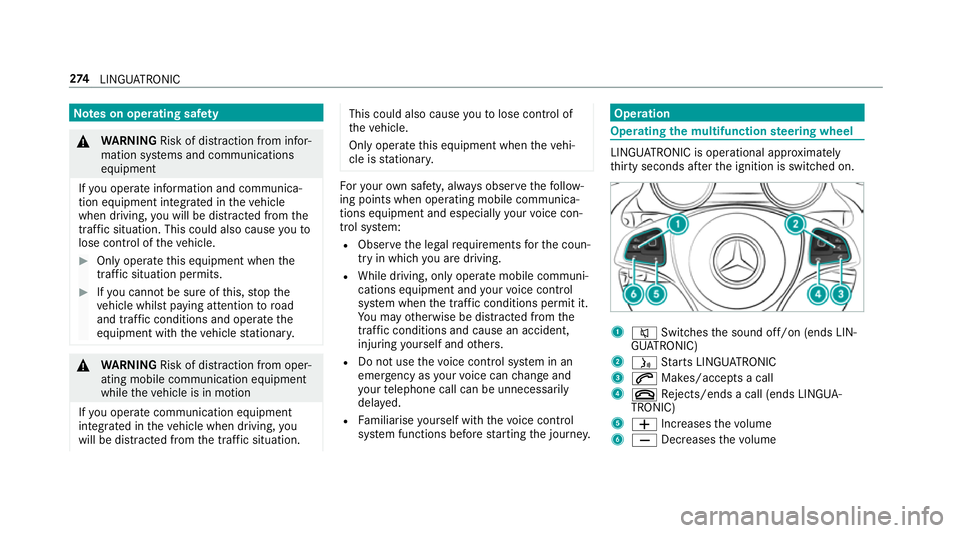
Note
sono perating saf ety &
WARNING Risk of di stra ction from infor‐
mation sy stems and communications
equipment
If yo uo perat einformation and communica‐
tio ne quipment integ ratedint hevehicle
when driving, youw ill be distracted from the
traf fics ituation. Thi scould also cause youto
lose control of thev ehicle. #
Onlyoperat ethis equipment when the
traf fics ituation permits. #
Ifyo uc anno tbes ureoft his,stop the
ve hicle whils tpaying attention toroad
and traf ficc onditions and ope rate the
equipment wit hthe vehicle stationar y. &
WARNING Risk of di stra ction from oper‐
ating mobil ecommunication equipment
while thev ehicle is in motion
If yo uo perat ecommun icationequipment
integrated in thev ehicle when driving, you
will be distracted from thet raffic situation. This could also cause
youtol ose control of
th ev ehicle.
Onl yoperat ethis equipment when thev ehi‐
cle is stationar y. Fo
ry our owns afet y, alwa ys obser vethef ollow‐
ing points when operating mobile communica‐
tions equipment and especiall yyour voice con‐
trol sy stem:
R Obser vethel egal requ irements fort he coun‐
tr yinw hichyou ar edriving.
R While driving, on ly operatem obile communi‐
cation sequipment and your voice control
sy stem when thet raffic condition spermit it.
Yo um ayotherwise be distracted from the
traf ficc onditions and cause an accident,
inju ring yourself and others.
R Do no tuse thev oice control sy stem in an
emer gency as your voice can chang eand
yo ur telephon ecall can be unnecessarily
dela yed.
R Familiarise yourself wit hthe voice control
sy stem function sbefor estartin gt he journe y. Operation
Operating
them ultifunction steering wheel LINGU
ATRO NIC is operational appr oximately
th irty seconds af tert he ignition is switched on. 1
8 Switches thes ound off/on (ends LIN‐
GU ATRO NIC)
2 ó Starts LINGU ATRO NIC
3 6 Makes/accepts acall
4 ~ Rejects/end sacall( en ds LINGUA‐
TRONIC)
5 W Increases thev olume
6 X Decreases thev olume 274
LINGU ATRO NIC